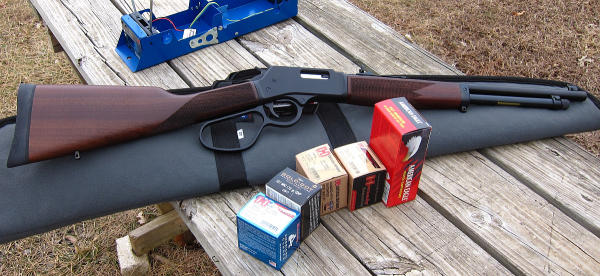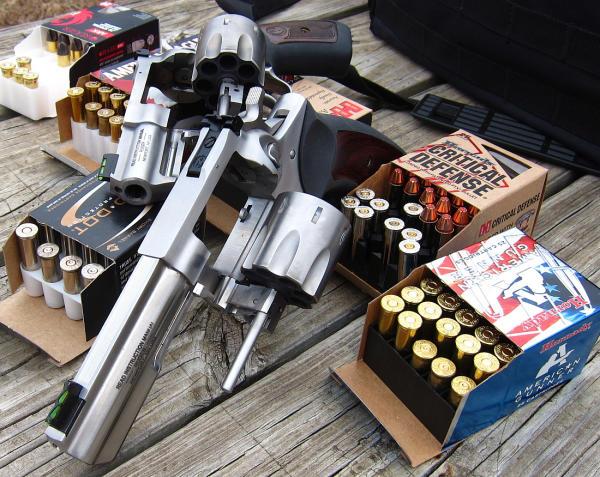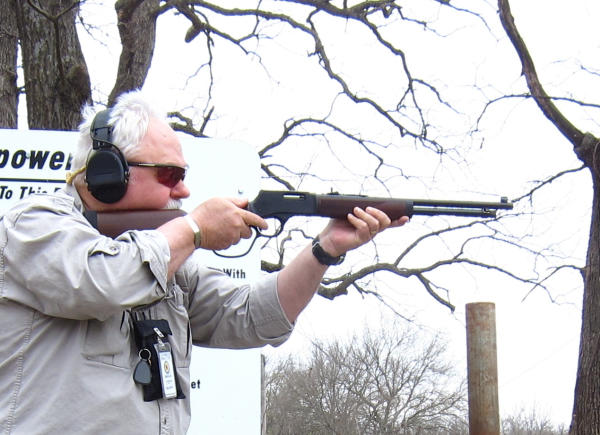
I’ve recently covered a pair of new 357 revolvers, Ruger’s superb GP100 in seven-shot format. The first has a barrel just over four-inches long, the other with a barrel of only 2 ½” in length.
As they’re both still here, and I still had the Henry Repeating Arms “Big Boy Steel” 357 Magnum carbine written up here last year, it seemed a good time to compare velocities from the range of barrel lengths. A 6 ½ pound, 16-inch barrel lever action carbine in .357 Magnum, the Henry carbine would provide the longer barrel and it’d be interesting to run the same rounds through it and both revolvers over a chronograph to see the difference – 16-inches to just over 4-inches and the snub. Just how much velocity is gained in the carbine over revolvers and how much is lost going from the “standard” holster gun length to the snub?
First, what difference does velocity make? That depends on your objective. If you’re shooting a paper target, it just has to be enough to stabilize the projectile in flight. If you’re shooting a steel target that’s stationary, likewise. If it’s reactive steel – think of a target like a“Pepper Popper” -- you need enough velocity and weight to carry the target down. If you’re hunting or using the piece for defense, you want enough velocity for accuracy like the paper target load, but the bullet has to be relevant to the likely impact velocity to enhance penetration and limit expansion (or fragmentation).
Is there a formula for velocity loss as the barrel is cut back? Well, not really. There’s a guess, but it’s complicated by the variation in weapon systems. The Henry lever gun is a closed system, chamber and barrel. Both revolvers have chambers separated from the barrel by the barrel/cylinder gap: the space needed to allow the rotation of the cylinder to bring the next loaded chamber into line with the barrel so it can be fired.

There is some loss of pressure at the cylinder gap. Don’t test it by putting your hand around the gun to see.
Within reason, as the (rifled) barrel is longer velocity will tend up as long as the powder behind the bullet is burning. Slower powder gives better velocity in longer barrels under normal circumstances. The bullet has to have enough weight to allow this to work well; very light-for-caliber bullets over slow powders can leave a lot of unburned powder – reducing efficiency.
Still, the 357 Magnum was a revolver caliber for hunting purposes when it was originated. Standard weight bullets – 158 grains – over a healthy supply of slow powder lit by a “magnum” rated primer gave generally good results. Since the advent of the 357 Magnum, it became a police revolver round and it still has interest from some quarters in defense.
I grabbed a selection of rounds to check. I included the Hornady LeverEvolution round, one meant for tubular magazines of 357 carbines thinking it would show some difference when fired from shorter barrels. While I was in the Hornady line, I grabbed their American Gunner 125 grain XTP in 357 as well as the Critical Defense 125 grain FTX Magnum.
The Speer 135 grain Gold Dot Magnum was listed as a “short barrel load,” the logical opposite of the LeverEvolution. I grabbed a box of Federal American Eagle 158 grain Jacketed Soft Point as it’s the standard form factor for the caliber from my earliest days as a gun owner: the first centerfire handgun I owned was a 357 and the motor sergeant assigned to the Group S3 shop went to Gibson’s with me because I couldn’t buy handgun ammo. I was only an E4 in the US Army, the government thought I was too dangerous to have a revolver.
The round purchased? Federal 158 grain JSP, just like the current American Eagle product.
Finally, I threw a box of 38s in the mix, the Ruger ARX 77 grain round. In my 2-inch LCRx, that load averaged 1024 fps. It’d be interesting to see what it’d get in the longer guns.
It was a decent day for winter, around 58 degrees. The Shooting Chrony was 10 feet from the muzzles. Velocity was measured in feet-per-second.
Velocities for 357 Magnum Across Barrel Lengths
|
Loads |
Henry BBS 357 16” |
GP100 4” |
GP100 2.5” |
|
Hornady American Gunner 125 gr. XTP Mag. |
2025 |
1370 |
1264 |
|
Speer 135 grain Gold Dot HP Mag. |
1395 |
1182 |
1098 |
|
Hornady Critical Defense 125 FTX Mag. |
1753 |
1392 |
1284 |
|
Hornady LeverEvolution 140 FTX Mag. |
1762 |
1406 |
1298 |
|
Federal American Eagle 158 gr. JSP Mag. |
1778 |
1267 |
1230 |
|
Ruger ARX 77 gr. 38 Special |
1340 |
1174 |
1129 |
The data are surprising for me. The velocity champ was Hornady American Gunner 125 grain XTP in the carbine, followed closely by the Federal American Eagle 158 grain JSP. Almost in the same category, the LeverEvolution was nearly identical in speed to the American Eagle and it was closely followed by the Critical Defense load.

Looking at the four-inch GP, The LeverEvolution was in first place (!) – followed by Critical Defense and American Gunner, in order. In the snub, LeverEvolution was in first place followed very closely by Critical Defense, American Gunner and American Eagle in order.
The 38 load still got over 1300 fps in the Henry Lever and lost velocity in both revolvers. There was nearly no difference between the revolvers with the 38 load. There was more difference between the GPs and the LCRx with the Ruger ARX load.
Interesting observations arise from the spreadsheet I did. The average velocities for all loads from the carbine was just over 1,675 fps, for the 4-inch GP was 1,299 fps and the snub was 1,217 fps. The average difference between the Henry and the 4-inch GP was a loss of 377 fps. The difference from the Henry and the snub averaged 458 fps and between the two revolvers the average loss was just 81 fps – almost no practical difference.
The LeverEvolution was a rip’snortin’ load from the revolvers – and wouldn’t necessarily be my first choice for regular use in them. I sure wouldn’t rule it out though, if that’s what I had. On the other hand, it’s a nicely balanced load for the HenryBig Boy Steel carbine and it would be a top choice for that gun. Likewise, the old standard 158 grain JSP from Federal/American Eagle is a load the long gun handles with ease. It’s certainly well-built enough that the higher velocity won’t compromise the bullet inside 100 yards.
As to the Ruger revolvers, if I had to center on one of these loads for both guns – I don’t – either of the Hornady 125 grain loads would do fine as would the Speer Gold Dot.
It was an interesting experiment made fun by the fact that I’m a huge fan of all three guns. I like shooting them.
- - Rich Grassi